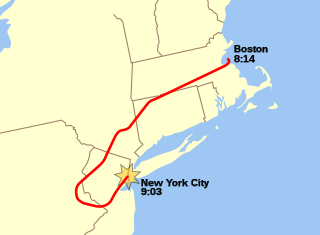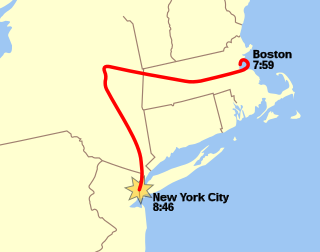Related Research Articles

American Airlines Flight 77 was a scheduled domestic transcontinental passenger flight from Dulles International Airport in Northern Virginia to Los Angeles International Airport in Los Angeles. The Boeing 757-223 aircraft serving the flight was hijacked by five al-Qaeda terrorists on the morning of September 11, 2001, as part of the September 11 attacks. The hijacked airliner was deliberately crashed into the Pentagon in Arlington County, Virginia, killing all 64 aboard and another 125 in the building.

Aircraft hijacking is the unlawful seizure of an aircraft by an individual or a group. Dating from the earliest of hijackings, most cases involve the pilot being forced to fly according to the hijacker's demands. There have also been incidents where the hijackers have overpowered the flight crew, made unauthorized entry into the cockpit and flown them into buildings – most notably in the September 11 attacks – and in several cases, planes have been hijacked by the official pilot or co-pilot; e.g., Ethiopian Airlines Flight 702.

Nawaf Muhammed Salin al-Hazmi was a Saudi terrorist hijacker who was one of five hijackers of American Airlines Flight 77, which they crashed into the Pentagon as part of the September 11 attacks.

United Airlines Flight 175 was a domestic passenger flight from Logan International Airport in Boston to Los Angeles International Airport in California that was hijacked by five al-Qaeda terrorists on the morning of September 11, 2001, as part of the September 11 attacks. The aircraft involved, a Boeing 767-200 carrying 65 passengers and crew, was deliberately crashed into the South Tower of the World Trade Center in New York City, killing everyone aboard and causing the deaths of more than 600 people in the South Tower's upper levels in addition to an unknown number of civilians and emergency personnel on floors beneath the impact zone. Flight 175's hijacking not only led to it being the second-deadliest of the four suicide attacks carried out on the day in terms of plane and ground fatalities, but also secured its place as second-deadliest plane crash in aviation history, surpassed only by American Airlines Flight 11.

United Airlines Flight 93 was a domestic scheduled passenger flight that was hijacked by four al-Qaeda terrorists on the morning of September 11, 2001, as part of the September 11 attacks. The hijackers planned to crash the plane into a federal government building in the national capital of Washington, D.C. The mission became a partial failure when the passengers fought back, forcing the terrorists to crash the plane in Somerset County, Pennsylvania, preventing them from reaching al-Qaeda's intended target, but killing everyone aboard the flight. The airliner involved, a Boeing 757-222 with 44 passengers and crew, was flying United Airlines' daily scheduled morning flight from Newark International Airport in New Jersey to San Francisco International Airport in California, making it the only plane hijacked that day not to be a Los Angeles–bound flight.

The USS Liberty incident was an attack on a United States Navy technical research ship, USS Liberty, by Israeli Air Force jet fighter aircraft and Israeli Navy motor torpedo boats, on 8 June 1967, during the Six-Day War. The combined air and sea attack killed 34 crew members, wounded 171 crew members, and severely damaged the ship. At the time, the ship was in international waters north of the Sinai Peninsula, about 25.5 nautical miles northwest from the Egyptian city of Arish.

Marwan Yousef Mohamed Rashid Lekrab al-Shehhi was an Emirati terrorist hijacker from al-Qaeda who served as the hijacker-pilot of United Airlines Flight 175, crashing the Boeing 767 into the South Tower of the World Trade Center as part of the 11 September attacks in 2001. He was one of five hijackers aboard the aircraft and one of two Emiratis to take part in the attacks, the other being Fayez Banihammad, who helped him hijack the same plane.

An aviation accident is defined by the Convention on International Civil Aviation Annex 13 as an occurrence associated with the operation of an aircraft, which takes place from the time any person boards the aircraft with the intention of flight until all such persons have disembarked, and in which (a) a person is fatally or seriously injured, (b) the aircraft sustains significant damage or structural failure, or (c) the aircraft goes missing or becomes completely inaccessible. Annex 13 defines an aviation incident as an occurrence, other than an accident, associated with the operation of an aircraft that affects or could affect the safety of operation.
The September 11 attacks of 2001, in addition to being a unique act of terrorism, constituted a media event on a scale not seen since the advent of civilian global satellite links. Instant worldwide reaction and debate were made possible by round-the-clock television news organizations and by the internet. As a result, most of the events listed below were known by a large portion of the world's population as they occurred.
The Joint Inquiry into Intelligence Community Activities before and after the Terrorist Attacks of September 11, 2001, is the official name of the inquiry conducted by the Senate Select Committee on Intelligence and the House Permanent Select Committee on Intelligence into the activities of the U.S. Intelligence Community in connection with the attacks of September 11, 2001. The investigation began in February 2002 and the final report was released in December 2002.
On September 11, 2001, 19 al-Qaeda terrorists took control of four commercial aircraft and used them as suicide weapons in a series of four coordinated acts of terrorism to strike the World Trade Center in New York City, The Pentagon in Arlington County, Virginia, and an additional target in Washington, D.C. Two aircraft hit the World Trade Center while the third hit the Pentagon. A fourth plane did not arrive at its target, but crashed into a field in Pennsylvania after a passenger revolt. The intended target is believed to have been the United States Capitol. As a result, 2,977 victims were killed, making it the deadliest foreign attack on U.S. soil, exceeding Japan's surprise attack on Pearl Harbor in Honolulu, Hawaii, on December 7, 1941, which killed 2,335 members of the United States Armed Forces and 68 civilians. The effort was carefully planned by al-Qaeda, which sent 19 terrorists to take over Boeing 757 and Boeing 767 aircraft, operated by American Airlines and United Airlines.
PENTTBOM is the codename for the Federal Bureau of Investigation's probe into the September 11 attacks of 2001, the largest criminal inquiry in the FBI's history. Its name stands for "Pentagon/Twin Towers Bombing Investigation". The investigation was launched on September 11, 2001, and involved 4,000 special agents and 3,000 professional employees.

The September 11 attacks, commonly known as 9/11, were four coordinated Islamist suicide terrorist attacks carried out by al-Qaeda against the United States on September 11, 2001. That morning, 19 terrorists hijacked four commercial airliners scheduled to travel from the East Coast to California. The hijackers crashed the first two planes into the Twin Towers of the World Trade Center in New York City, two of the world's five tallest buildings at the time, and aimed the next two flights toward targets in or near Washington, D.C., in an attack on the nation's capital. The third team succeeded in striking the Pentagon, the headquarters of the U.S. Department of Defense in Arlington County, Virginia, while the fourth plane crashed in rural Pennsylvania during a passenger revolt. The September 11 attacks killed 2,977 people, making them the deadliest terrorist attack in history, and instigated the multi-decade global war on terror, fought in Afghanistan, Iraq, and elsewhere.

Unit 8200 is an Israeli Intelligence Corps unit of the Israel Defense Forces responsible for clandestine operation, collecting signal intelligence (SIGINT) and code decryption, counterintelligence, cyberwarfare, military intelligence, and surveillance. Military publications include references to Unit 8200 as the Central Collection Unit of the Intelligence Corps, and it is sometimes referred to as Israeli SIGINT National Unit (ISNU). It is subordinate to Aman, the military intelligence directorate.
Various conspiracy theories allege that certain institutions or individuals had foreknowledge of the September 11 attacks in the United States in 2001. Some of the primary debates include whether the Bush administration or the United States Armed Forces had awareness of the planned attack methods, the precise volume of intelligence that American agencies had regarding al-Qaeda activities inside the United States, whether the put options placed on United Airlines and American Airlines and other trades indicated foreknowledge, and why the identities of the traders have never been made public.
The 9/11 Commission, which investigated the terrorist September 11 attacks on the United States, was subject to a variety of criticisms by politicians, government officers, and private groups and citizens. The commission was created on November 27, 2002 by a bill passed by the U.S. Congress and signed into law by President George W. Bush.

American Airlines Flight 11 was a domestic passenger flight that was hijacked by five al-Qaeda terrorists on the morning of September 11, 2001, as part of the September 11 attacks. The hijacked airliner was deliberately crashed into the North Tower of the World Trade Center complex in New York City, killing everyone aboard the flight and resulting in the deaths of more than one thousand people in the top 18 stories of the skyscraper in addition to causing the demise of numerous others below the trapped floors, making it not only the deadliest of the four suicide attacks executed that morning in terms of both plane and ground fatalities, but also the single deadliest act of terrorism in human history and the deadliest plane crash of all time. The aircraft involved, a Boeing 767-223ER with 92 passengers and crew, was flying American Airlines' daily scheduled morning transcontinental service from Boston Logan International Airport in Massachusetts to Los Angeles International Airport in California.
At around 9:30 pm on September 11, 2001, George Tenet, director of the Central Intelligence Agency (CIA) told President George W. Bush and U.S. senior officials that the CIA's Counterterrorism Center had determined that Osama bin Laden and al-Qaeda were responsible for the September 11 attacks. Two weeks after the terrorist attacks on September 11, 2001, the Federal Bureau of Investigation connected the hijackers to al-Qaeda, a militant Salafist Islamist multi-national organization. In a number of video, audio, interview and printed statements, senior members of al-Qaeda have also asserted responsibility for organizing the September 11 attacks.
The following outline is provided as an overview of and topical guide to the September 11 attacks and their consequences:
In the aftermath of the September 11 attacks on New York City and Washington, D.C., by the al-Qaeda terrorist group, a number of investigations were conducted to determine what intelligence may have existed before the attacks and whether this information was ignored by authorities.
References
- ↑ "Definition of Black Swan, BuzzWord from Macmillan Dictionary". www.macmillandictionary.com. Retrieved 2020-05-18.
- ↑ Mother Jones interview with Graham
- ↑ National Security Archive
- ↑ White House briefing with Condoleezza Rice
- ↑ NTSB report
- ↑ Answers.com report
- ↑ https://www.aopa.org/advocacy/advocacy-briefs/gore-commission-final-report The Core Commission Report
- ↑ https://www.9-11commission.gov/report/911Report.pdf 9/11 Commission Report
- ↑ "Final Report of the National Commission on Terrorist Attacks Upon the United States: Executive Summary". National Commission on Terrorist Attacks Upon the United States. 2004-01-27. Retrieved 2009-09-20.
- ↑ "The Unknown Known". IMDb .
- ↑ "Israel's failure of imagination on Hamas". 7 October 2023.